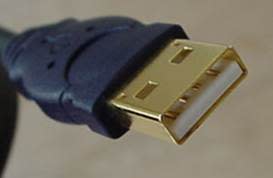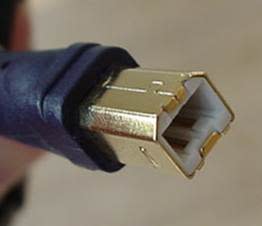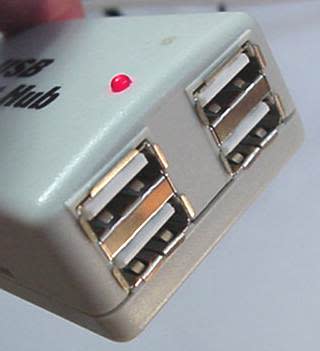Understanding USB Types and the Flexible USB System
Compared to other ways of connecting devices to your computer (including parallel ports, serial ports and special cards that you install inside the computer's case), Universal Serial Bus connectors are incredibly simple.
Here, we'll look at USB types from both a user and a technical standpoint. You'll learn why the USB system is so flexible and how it's able to support so many devices so easily.
Why USB Connectors Are So Handy
Anyone who has been around computers for a while understands the issue Universal Serial Bus addresses: In the past, connecting devices to computers has been a real headache.
Printers connected to parallel printer ports, and most computers only came with one. Things like external storage media, which need a high-speed connection into the computer, would use the parallel port as well, often with limited success and not much speed.
Modems used the serial port, but so did some printers and a variety of odd things like personal digital assistants (PDAs) and digital cameras. Most computers had at most two serial ports, and they were very slow in most cases.
Devices that needed faster connections came with their own cards, which had to fit in a card slot inside the computer's case. Unfortunately, the number of card slots is limited and some of the cards are difficult to install.
The goal of USB has been to end all of these headaches. The Universal Serial Bus has offered a single, standardized, easy-to-use way to connect up to 127 devices to a computer.
USB Cable Types
Connecting a USB device to a computer is simple: You find the USB connector on the back of your machine and plug the USB connector into it. (These days, newer machines and mobile devices are more likely to have USB-C ports.)
If it's a new device, the operating system auto-detects it and asks for the driver disk. If you have already installed the device, the computer activates it and starts talking to it. You can connect and disconnect USB devices at any time. Here are a few different types of USB cables:
USB Type-A

Many USB devices come with their own built-in cable, and the cable has an "A" connection on it. This common type of USB connector has a flat, elongated shape. You can only plug it in one orientation.
USB Type-B

You would typically use a USB Type-B connector for larger devices. With an almost square shape, this connector has a slightly beveled top corner, making it easier to insert correctly.
Type-B connectors are usually on the opposite end of a Type-A cable. ("A" connectors head "upstream" toward the computer and "B" heads "downstream" and connects to individual devices.
USB Type-C
A USB-C cable is compact and reversible, so you can insert it in any orientation. It is optimal for high-speed data transfer and power delivery across various devices.
The USB Type-C connector supports the USB 3.1 standard, which enables data transfer speeds of up to 10 Gbps and power delivery of up to 100 watts, facilitating faster charging and efficient data handling.
USB Mini
A USB-mini connector, or mini-USB, connects a variety of smaller devices like digital cameras, MP3 players and older mobile phones to computers for data transfer and charging. It is smaller than the standard USB Type-A connector but larger than the more recent Micro-USB and USB Type-C connectors.
Mini-USB comes in two main forms: Mini-A and Mini-B. Largely phased out and replaced by Micro-USB and USB Type-C connectors in most consumer electronics, Mini-USB is still sometimes in use.
USB Micro
A USB-micro connector is a compact version of the USB interfaces. It is mostly for small, portable devices like smartphones, tablets and digital cameras. It comes in two forms: Micro-A and Micro-B.
USB Hubs
Most computers that you buy today come with at least one or two USB sockets. But with so many USB devices on the market, you easily run out of sockets very quickly. For example, you could have a keyboard, mouse, printer, microphone and webcam all running on USB technology, so the obvious question is, "How do you hook up all the devices?"
The easy solution to the problem is to buy an inexpensive USB hub. The USB standard supports up to 127 devices, and USB hubs are a part of the standard.

A hub typically has four new ports but may have many more. You plug the hub into your computer, and then plug your devices (or other hubs) into the hub. By chaining hubs together, you can build up dozens of available USB ports on a single computer.
The USB standard allows for devices to draw their power from their USB connection. A high-power device like a printer or scanner will have its own power supply, but low-power devices like mice and digital cameras get their power from the bus in order to simplify them. The power (up to 500 milliamps at 5 volts for USB 2.0 and 900 milliamps for USB 3.0) comes from the computer.
If you have lots of self-powered devices (like printers and scanners), then you don't need a powered hub; none of the devices connecting to the hub needs additional power, so the computer can handle it.
If you have lots of unpowered devices like mice and cameras, you probably need a powered hub. The hub has its own transformer and it supplies power to the bus so that the devices don't overload the computer's supply.
The USB Process
When the host powers up, it queries all of the devices connected to the bus and assigns each one an address. This process is enumeration; devices are also enumerated when they connect to the bus. The host also finds out from each device what type of data transfer it wishes to perform:
Interrupt: A device like a mouse or a keyboard, which will be sending very little data, would choose the interrupt mode.
Bulk: A device like a printer, which receives data in one big packet, uses the bulk transfer mode. The printer receives a block of data (in 64-byte chunks) and verifies it to make sure it's correct.
Isochronous: A streaming device (such as a speaker) uses the isochronous mode. Data streams between the device and the host in real-time, and there is no error correction.
The host can also send commands or query parameters with control packets.
As devices are enumerated, the host is keeping track of the total bandwidth that all of the isochronous and interrupt devices are requesting. They can consume up to 90 percent of the 480 Mbps of bandwidth that's available (USB 3.0 increases that speed to 4.8 gigabits per second).
After 90 percent is used up, the host denies access to any other isochronous or interrupt devices. Control packets and packets for bulk transfers use any bandwidth left over (at least 10 percent).
The Universal Serial Bus divides the available bandwidth into frames, and the host controls the frames. Frames contain 1,500 bytes, and a new frame starts every millisecond.
During a frame, isochronous and interrupt devices get a slot so they're guaranteed the bandwidth they need. Bulk and control transfers use whatever space is left. The technical links at the end of the article contain lots of detail if you'd like to learn more.
USB Features
The Universal Serial Bus has the following features:
The computer acts as the host.
Up to 127 devices can connect to the host, either directly or by way of USB hubs.
Individual USB cables can run as long as 5 meters; with hubs, devices can be up to 30 meters (six cables' worth) away from the host.
With USB 2.0, the bus has a maximum data rate of 480 megabits per second (10 times the speed of USB 1.0).
A USB 2.0 cable has two wires for power (+5 volts and ground) and a twisted pair of wires to carry the data. The USB 3.0 standard adds four more wires for data transmission. While USB 2.0 can only send data in one direction at a time (downstream or upstream), USB 3.0 can transmit data in both directions simultaneously.
On the power wires, the computer can supply up to 500 milliamps of power at 5 volts. A USB 3.0 cable can supply up to 900 milliamps of power.
Low-power devices (such as mice) can draw their power directly from the bus. High-power devices (such as printers) have their own power supplies and draw minimal power from the bus. Hubs can have their own power supplies to provide power to devices connected to the hub.
USB devices are hot-swappable, meaning you can plug them into the bus and unplug them any time. A USB 3.0 cable is compatible with USB 2.0 ports — you won't get the same data transfer speed as with a USB 3.0 port, but data and power will still transfer through the cable.
Many USB devices can be put to sleep by the host computer when the computer enters a power-saving mode.
The devices connected to a USB port rely on the cable to carry power and data.
Subsequent Generations of USB Technology
USB 2.0
The standard for USB version 2.0 came out in April 2000 and served as an upgrade for USB 1.1.
USB 2.0 provided additional bandwidth for multimedia and storage applications and has a data transmission speed 40 times faster than USB 1.1. To allow a smooth transition for both consumers and manufacturers, USB 2.0 had full forward and backward compatibility with original USB devices and works with cables and connectors made for original USB.
Supporting three speed modes (1.5, 12 and 480 megabits per second), USB 2.0 supports low-bandwidth devices such as keyboards and mice, as well as high-bandwidth ones like high-resolution webcams, scanners, printers and high-capacity storage systems.
The deployment of USB 2.0 allowed PC industry leaders to forge ahead with the development of PC peripherals to complement existing high-performance PCs.
In addition to improving functionality and encouraging innovation, USB 2.0 increases the productivity of user applications and allows the user to run multiple PC applications at once or several high-performance peripherals simultaneously.
USB 3.0
The USB 3.0 standard became official on Nov. 17, 2008 [source: Everything USB]. USB 3.0 boasts speeds 10 times faster than USB 2.0 at 4.8 gigabits per second.
It was meant for applications such as transferring high-definition video footage or backing up an entire hard drive to an external drive. As hard drive capacity grew, the need for a high-speed data transfer method also increased.
USB-C
The USB-C technology, introduced as the new standard in 2014, revolutionized connectivity with its versatile and high-performance capabilities. USB-C offers a significant upgrade over USB 3.0, with data transfer speeds of up to 10 gigabits per second, more than doubling the speed of its predecessor.
This advancement supports the growing demand for rapid data transfer, making it ideal for tasks like transferring ultra-high-definition video or large data files swiftly.
The reversible design of USB-C cables and the USB-C port simplifies connections and enhances user convenience, while its support for various protocols — including power delivery — enables faster charging and greater functionality across a wide range of devices, from smartphones to laptops and beyond.
We updated this article in conjunction with AI technology, then made sure it was fact-checked and edited by a HowStuffWorks editor.
Lots More Information
Sources
Chan, Norman. "Everything You Need to Know About USB 3.0, Plus First Spliced Cable Photos." Maximum PC. Aug. 18, 2008. (Jan. 28, 2011)http://www.maximumpc.com/article/features/everything_you_need_know_about_usb_30_plus_first_spliced_cable_photos
Europa. "Harmonisation of a charging capability of common charger for mobile phones - frequently asked questions." June 29, 2009. (Jan. 31, 2011) http://europa.eu/rapid/pressReleasesAction.do?reference=MEMO/09/301
Everything USB. "SuperSpeed USB 3.0 FAQ." Feb. 1, 2011. (Feb. 1, 2011) http://www.everythingusb.com/superspeed-usb.html
Faas, Ryan. "Will Light Peak leave USB 3.0 in the dust?" IT World. Nov. 5, 2010. (Jan. 31, 2011) http://www.itworld.com/hardware/126694/will-light-peak-leave-usb-30-dust
Ganapati, Paul. "Intel's Light Peak Technology Could Kill USB 3.0." Wired. April 15, 2010. (Jan. 28, 2011) http://www.wired.com/gadgetlab/2010/04/intels-light-peak-technology-could-kill-usb-30/
Intel. "Extensible Host Controller Interface (xHCI) Specification for USB 3.0." (Jan. 31, 2011) http://www.intel.com/technology/usb/xhcispec.htm
Kingsley-Hughes, Adrian. "Is Intel delaying USB 3.0 to give Light Peak an advantage?" ZDNet. June 3, 2010. (Jan. 31, 2011) http://www.zdnet.com/blog/hardware/is-intel-delaying-usb-30-to-give-light-peak-an-advantage/8493
Knupffer, Nick. "USB 3.0 for the masses - Dispelling the myths." Intel. June 11, 2008. (Jan. 31, 2011) http://blogs.intel.com/technology/2008/06/usb_30_for_the_masses_dispelli.php
Lilly, Paul. "Intel's Light Peak Technology vs USB 3.0." Tested. April 15, 2010. (Jan. 28, 2011) http://www.tested.com/news/intels-light-peak-technology-vs-usb-30/160/
Perenson, Melissa J. "USB 3.0 Finally Arrives." PCWorld. Jan. 10, 2010. (Jan. 28, 2011) http://www.pcworld.com/article/186566/usb_30_finally_arrives.html
Universal Serial Bus. "USB 3.0 Specification." (Jan. 28, 2011) http://www.usb.org/developers/docs/
Original article: Understanding USB Types and the Flexible USB System
Copyright © 2024 HowStuffWorks, a division of InfoSpace Holdings, LLC, a System1 Company

